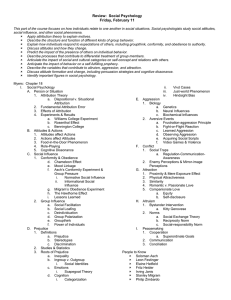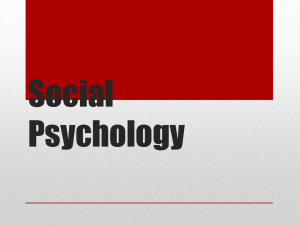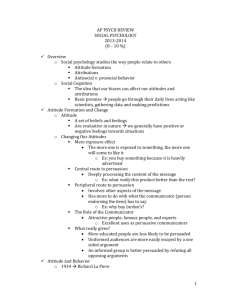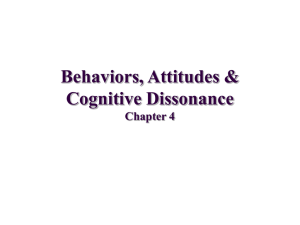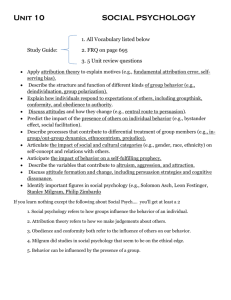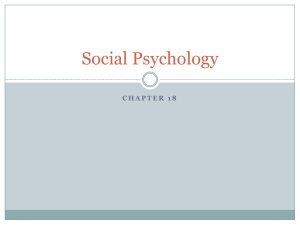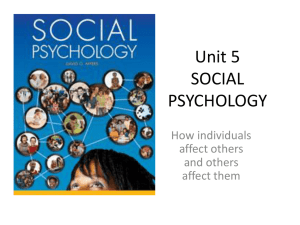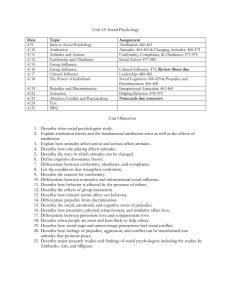Social Psychology
advertisement
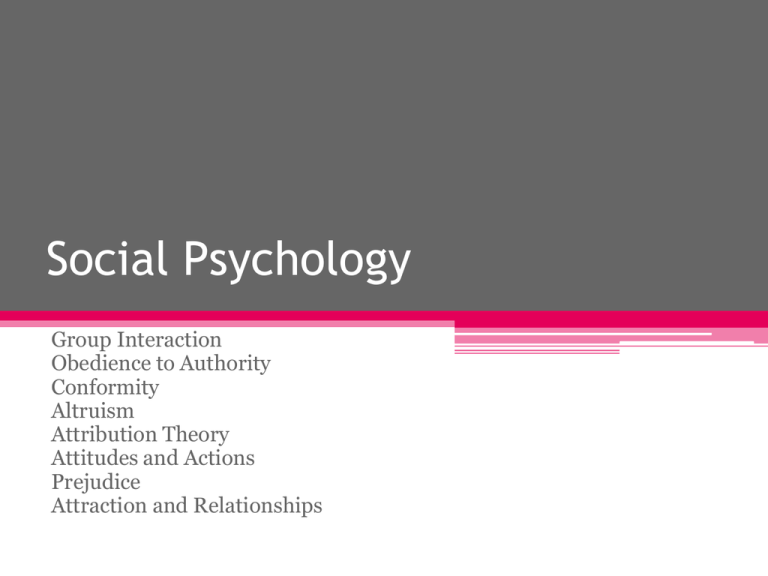
Social Psychology Group Interaction Obedience to Authority Conformity Altruism Attribution Theory Attitudes and Actions Prejudice Attraction and Relationships Deindividuation • Deindividuation: refers to behavior in which any individual loses any sense of identity and personal responsibility while part of a crowd. • Used to explain behavior of otherwise just individuals in riots, concerts, sporting events, etc. Group Think • Group think: occurs when the desire for harmony in a decision-making group overrides a realistic appraisal of the situation • Criticism are not raised. • Alternative solutions not offered. • Idea that it is better to get along in a group than to argue. • “Devil’s Advocate” used to curb group think. Group Polarization • In group polarization group decisions end up as extreme versions of the individual member’s predispositions. • A group of moderate conservatives meet to propose legislation and members resultantly propose more extreme conservative legislation. • A group of moderate liberals meet to propose legislation and members resultantly propose more extreme liberal legislation. Social Loafing • Social loafing: tendency for individuals in groups to exert less effort towards a common goal. • “Riding someone’s coattails” • Tug of War example: individuals don’t pull as hard in a group as they would pulling solo. Social Facilitation and Inhibition • Research shows that the presence of others can either facilitate or inhibit your performance. • In social facilitation an audience tends to aid your performance if it is a task you know well. • In social inhibition an audience tends to hinder your performance if it is a task you are not familiar with. Obedience • Obedience refers to doing a thing because someone (an authority figure) told you to do so. Obedience to Authority • After World War II many social psychologists became interested in explaining how the Nazis convinced people to follow through with atrocious acts during the Holocaust. • In the early 1960s, Yale researcher Stanley Milgram carried out one of the most important studies in all of psychology. • He wanted to see how far normal people would go at the request of an authority figure. Milgram’s Obedience Experiment • Milgram created a situation in which an authority figure ordered a volunteer to “teach” another volunteer and to punish that “learner” (an accomplice of the experiment) if and when he made a mistake. • Electric shocks were used as the punisher. • The teacher could administer increasing levels of shock up to a maximum 450 volts. • The teacher and learner communicated via microphone in separate rooms. Results of the Milgram Study • Milgram’s colleagues predicted that only 1 in 1,000 subjects would administer the maximum 450 volts. • In actuality 2/3 of Milgram’s “teachers” went all the way despite the “learner’s” continuous complaints about heart problems. • Highlighted the effect of authority figures on the actions of individuals. • Study became a catalyst to revision and implementation of ethical guidelines in conducting psychological research. Conformity • Conformity refers to a kind of “going along” with others or with some societal expectation. • Two main reasons for conformity: • 1. normative social influence: results from a person’s desire to gain approval or avoid disapproval • 2. informational social influence: results from one’s willingness to accept others’ opinions about reality that may provide valuable information Solomon Asch’s Conformity Experiment • Solomon Asch conducted studies in the 1950’s on conformity to group pressure. • He seated a number of individuals together and asked them to verbally respond to some questions. • All but one of the participants were accomplices of Asch who had told them to give obviously wrong answers. • The idea was to see if the target volunteer went along with those answers, even against their better judgment. Results of Asch’s Experiment • Asch discovered that people were quite likely to conform to the group pressure. • He found that rates of conformity increased as group size increased up to about 4 individuals. • After group size reached 4 the levels of conformity somewhat plateaued. • One factor more important than size of the group was unanimity. • Even if one accomplice did not go along with the group, that made it up easier for the target volunteer to avoid conforming as well. Altruism • Altruism: the unselfish regard for the welfare of others • Psychologists who focus on altruism attempt to explain the conditions in which a person is most likely to offer help or assistance to others. The Bystander Effect • Bystander Effect: tendency for any given bystander to be less likely to give aid if other bystanders are present. • Individuals seem to think that “someone else will do it”, a phenomenon called diffusion of responsibility. The Norms for Helping • Social Exchange Theory: our social behavior is an exchange process. • Goal is to maximize benefits and minimize costs. • We become socialized through norms that teach us how we ought to behave often to our mutual benefit. • Two types of socialized norms: • 1. Reciprocity norm: expectation that we should return help and not harm those who have helped us. • 2. Social Responsibility norm: tells us to help others when they need us even though they may not repay us Attribution Theory • Attribution Theory: inferences that people draw about the causes of events, others’ behavior and their own behavior • In the 1950’s Fritz Heider coined two terms to explain attribution theory: • 1. dispositional (internal) attributions: ascribe causes of behavior to traits, abilities and feelings • 2. situational (external) attributions: ascribe causes of behavior situational demands and environmental restraints Fundamental Attribution Error • The fundamental attribution error refers to an observers’ bias in favor of internal attributions in explaining others’ behavior. • Proposed reasons why observers tend to blame the person rather than the situation: • 1. Situational pressures may not be readily apparent to observer. • 2. Attributing behavior to dispositions is effortless, almost automatic process. Defensive Attribution • Defensive attribution: tendency to blame victims for their misfortune, so that one feels less likely to be victimized in a similar way. • Let’s say your friend gets mugged. • You may attribute the mugging to your friend’s carelessness or stupidity rather than bad luck. • Why? • Because if you attribute it to bad luck, you have to face the reality that it could as easily happen to you! Attitudes • Attitudes are feelings often based on our beliefs that predisposes us to respond in a particular way to objects, people and events. • Made up of three components: • 1. Cognitive component: beliefs people hold about the object • 2. Affective component: emotional feelings stimulated by an object of thought • 3. Behavioral component: predispositions to act in certain ways toward an attitude object • Question remains: Do attitudes affect actions? Do actions affect attitudes? Two Types of Attitudes • Explicit attitudes: attitudes that we hold consciously and can readily describe • Implicit attitudes: covert attitudes that are expressed in subtle automatic responses that people have little conscious control over Foot-in-the-door Phenomenon • Foot-in-the-door phenomenon: tendency for people who have first agreed to a small request to comply later with a larger request Zimbardo’s Stanford Prison Experiment • To investigate the relationship between attitudes and actions, Phillip Zimbardo carried out his infamous “Prison Experiment” in the 1972. • He asked students to play roles in a “prison” established at Stanford University. • Volunteers were randomly assigned to play either guards or prisoners in the two week experiment. Results of Zimbardo’s Experiment • Zimbardo’s two week study had to be cut short after only 6 days. • The guards had conformed so much to what was expected of their role that they began to punish and humiliate the prisoners in manners that could possibly cause harm. • The guards’ attitudes towards their role as guards influenced their actions in the “prison”. • As was the case with Milgram, Zimbardo’s experiment also brought up many ethical concerns of psychological research. Cognitive Dissonance • According to Leon Festinger, cognitive dissonance exists when related cognitions are inconsistent – that is, when they contradict each other. • This contradiction creates an unpleasant state of tension that motivates people to reduce their dissonance. • To reduce this dissonance, people must change their behaviors or modify their attitudes. Cognitive Dissonance • Example: When someone who believes that cruelty to animals is wrong kicks a friend’s pet dog for eating his Twinkie this person is likely to feel uneasy at the discrepancy between their beliefs and their actions. • Two ways to reduce cognitive dissonance: • 1. They see a problem with their actions, apologize to their friend and go out and buy the dog a treat. OR • 2. See that the dog was really not harmed and become comfortable with some form of animal cruelty as long as it was a deserved punishment. Self-Fulfilling Prophecies • In a self-fulfilling prophecy our own expectations actually cause them to come true. • Example: You believe that you are not good enough for your girlfriend and you act according to this belief. Ultimately your actions relating to how you treat her confirm your beliefs and she breaks up with you. • Example: A manager of a store thinks a certain worker is a competent and valuable employee. He treats that worker with respect and encourages him even after failures. Ultimately the worker will indeed prove to be a good employee. Factors to Changing Attitudes: Persuasion • The process of persuasion includes four basic elements: • 1. Source: person who sends a communication ▫ More effective if source is credible, has expertise, is trustworthy, attractive and/or likeable. • 2. Receiver: person to whom the message is sent ▫ More effective through use of fear, providing a two-sided argument and repetition of the message. • 3. Message: information transmitted by the source ▫ More effective when unexpected and when attitudes of receiver is weak or indifferent. • 4. Channel: medium through which the message is sent ▫ Can include TV, radio, newspaper, telephone or in person. Two Routes to Persuasion • While there are four basic elements to the process of persuasion, there are two “paths” people take in actually being persuaded. • Central route to persuasion: involves being persuaded by the arguments or the content of the message ▫ For example, after hearing a political debate you may decide to vote for a candidate because you found the candidates views and arguments very convincing. • Peripheral route to persuasion: involves being persuaded in a manner that is not based on the arguments or the message content. ▫ For example, after reading a political debate you may decide to vote for a candidate because you like the sound of the person's voice, or the person went to the same university as you did. Prejudice • Prejudice: unjustifiable attitude toward a group and its members • Usually involves the three components of attitudes: ▫ 1. stereotyped beliefs (cognitive) ▫ 2. negative feelings (affective) ▫ 3. predisposition to discriminatory action (behavioral) • Keep in mind discrimination is unjustifiable action toward a group and its members Us v. Them: In-group/Out-group • Through our social identities, we associate ourselves with certain groups and contrast ourselves with others. • In-group: “us”; people with whom one shares a common identity • Out-group: “them”; those perceived as different or apart from one’s in-group • This “us v. them” mentality can lead to in-group bias: the tendency to favor one’s own group Ethnocentrism • Ethnocentrism: tendency to think that your nation or culture is superior to others. Scapegoat Theory • When things go wrong, finding someone to blame can provide a target for one’s anger. • Scapegoat Theory: theory that prejudice offers an outlet for anger by providing someone to blame Just-World Phenomenon • Just-world Phenomenon: belief that the world is just and that people get what they deserve and deserve what they get • Good is rewarded with good; evil with evil. • “What goes around comes around.” • Which groups tend to belief most strongly in the just world phenomenon? • Which groups tend to belief less strongly? • Why? Psychology of Attraction Social psychologists agree that there are three “keys” to interpersonal relationships: 1. Proximity: physical closeness of two individuals 2. Physical attractiveness 3. Similarity: how alike two people are Mere-Exposure Effect • Mere-exposure effect: phenomenon that repeated exposure to novel stimuli increases liking of them Theories of Love • In the 1970’s John Lee identified six types of love styles: • 1. Eros: passionate physical and emotional love based on aesthetic enjoyment • 2. Ludus – a love that is played as a game or sport • 3. Storge – an affectionate love that slowly develops from friendship • 4. Pragma – love that is driven by the head, not the heart • 5. Mania – obsessive love; experience great emotional highs and lows; very possessive and often jealous lovers • 6. Agape – selfless altruistic love Theories of Love • Robert Sternberg: most know for his “triarchic theory of intelligence” also came up with his own “triarchic theory of love”. • The main “goal” of love according to Sternberg is what he called consummate love. • Consummate love is made up of three components: • 1. passion: intense desire to be with the other person • 2. intimacy: emotional closeness • 3. commitment: desire to maintain the relationship • Other specific forms of love are made up of combinations of these three components.
